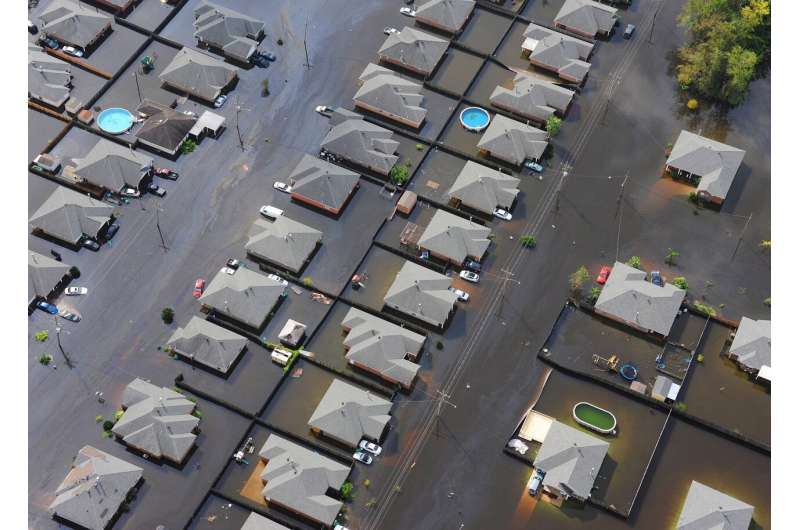This article has been reviewed according to Science X's editorial process and policies. Editors have highlighted the following attributes while ensuring the content's credibility:
fact-checked
proofread
Enhancing coastal cities' flood resilience through smart city technologies

Over the rest of this century due to global warming, coastal populations are likely to face increased risk of flooding. A team of researchers has proposed how the integration of Internet of Things, 5G mobile telephony, big data and machine learning into "smart cities" can be harnessed to enhance urban flood resilience.
Their paper surveying the state of urban flood resilience studies and the prospects for smart-city technologies and platforms was published on November 13 in Ocean-Land-Atmosphere Research.
As the global climate warms, one of the most immediate risks humanity faces is the growing threat of coastal flooding, at a time when human civilization is increasingly urban and living in coastal areas. By 2030, roughly half of the world's population will be living along the shoreline. At the same time, the pace of infrastructure construction has not kept pace with these steadily increasing coastal, urban populations, leading to inadequate flood prevention systems and leaving densely populated areas at high risk.
Climate change ramps up the flood threat in three key ways: rising sea levels, more intense rainfall events, and storm surges. The incidence of these coming together at the same time, what researchers call "compound flooding," is also increasing.
In the face of the growing danger from flooding, a paradigm of adaptation to the threat has in recent years been replaced with one of resilience. Adaptation describes those actions that are taken to adjust to new conditions, while resilience understands that there may be no permanent set of new conditions, and so society instead has to develop the capacity to anticipate novel external shocks, cope with them as they happen, and then spring back from them after the shock has passed.
In the case of urban flood resilience, the societal approach has thus evolved from just attempting to prevent floods to also being able to cope with them when they do inevitably happen, and recover from the effects of flood damage in a timely and effective manner.
However, while the discourse has moved on from a prevention-only paradigm, and both researchers and policy-makers have developed concepts and frameworks for resilience, there remain major gaps in a consistent approach to rigorous quantification of the resilience concept.
"We've seen a great many frameworks for urban flood resilience that have been proposed and have even begun to be implemented," said Dr. Ping Shen, a co-author of the study and a technologist with the State Key Laboratory of Internet of Things for Smart Cities at the University of Macau, "but there is still no consensus in the research community or at the level of political leadership on how to measure resilience."
The researchers argue that a range of emerging technologies brought together in the concept of the "smart city" can markedly enhance flood resilience while also enabling the development of quantification that itself is a key mechanism of resilience.
A smart city is any urban location that leverages innovations such as the Internet of Things (IoT), 5G connectivity, big data and artificial intelligence, as well as an interconnected infrastructure, to enhance city life. These recent innovations can be integrated into urban design to enable real-time data collection, analysis, and decision-making, leading to more responsive and resilient urban environments.
But up to now, the role of smart city frameworks in enhancing urban flood resilience has not been fully explored. Smart city technologies and platforms have been increasingly used in research studies but there has been little city-scale implementation of them in coastal disaster management.
And so the researchers conducted a systematic review of the literature on coastal flood risk assessment and resilience evaluation, particularly with respect to smart-city platforms. Then based on that review, the team developed a proposal for a smart-city-based coastal flood resilience management system covering the three periods of coastal flooding risk: pre-disaster, during-disaster, and post-disaster recovery.
Prior to a flood, multi-scale models are needed to assess flood risk and provide a scientific basis for decision-makers. Many studies have obtained flood probability, extent and depth through simulations. But few studies have considered the dynamics of human behavior, as it is conventionally a challenge to obtain reliable and empirical data on human behavior. Smart-city technologies should be able to combine existing understanding of flood dynamics with human dynamics obtained via IoT and big data, and so the scope of compound flood risk in coastal areas can be better estimated.
In addition, coastal city real-time monitoring systems, disaster forecasting, flood control and reduction systems, and emergency warning and response systems must be strengthened. The massive volume of information collected in the construction of smart cities can be shared as a data source for analysis and in support of early warning decisions.
Then, during a flood event, emergency rescue can be aided by Big Data. The integration of data from smart devices throughout a city can help to achieve panoptical, real-time monitoring of urban flood processes to more efficiently allocate emergency-rescue capacity.
After a flood, conducting timely and accurate damage assessments is critical for the efficient allocation of resources and swift recovery efforts. Technologies such as remote sensing (RS), geographic information systems (GIS), and artificial neural networks (ANNs) not only enhance the speed and accuracy of damage assessments but also enable a more data-driven and responsive approach to post-disaster management.
The study notes, however, that successful integration of smart-city technologies within coastal flood resilience frameworks will depend on improving data accessibility, enhancing interoperability and greater cross-discipline collaboration. Data quality, privacy, and security issues must also be addressed. Moving forward, the research team aims to focus on analysis of these more social elements of smart-city flood resilience.
More information: Ping Shen et al, Coastal flood risk and smart resilience evaluation under changing climate, Ocean-Land-Atmosphere Research (2023). DOI: 10.34133/olar.0029
Provided by Ocean-Land-Atmosphere Research (OLAR)





















